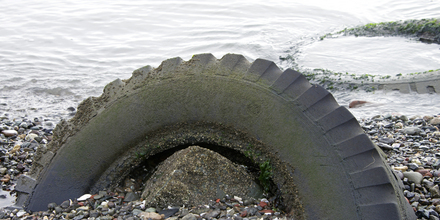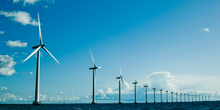Climate Change & Energy
Our Work
Latest in Mitigation
-

IEEP contributes to free online course on marine litter for United Nations Environment
The United Nations Environment’s second Massive Open Online Course (MOOC) on marine litter was created to educate participants at all levels and backgrounds to take action on marine ...
-
IEEP on France 24
Céline Charveriat discusses US withdrawal from Paris Accord and breaking Antarctic ice shelf.
-
IEEP on CNBC Asia
US absence and China leadership mark tectonic shift in global climate politics.
-
The consequences of climate change for EU Agriculture: Follow up to the COP21 UN Climate Change conference
With its potential to reduce GHG emissions and increase CO2 removals, agriculture has a key role to play in the EU’s climate mitigation efforts, yet Member State action is lacking. As pressure on the sector to act increases, the development of a 2050 low-carbon and resilience roadmap for European agriculture would be one step towards putting the sector on a more ambitious trajectory towards the transformation required to achieve net zero emissions by 2050.
-
Agriculture and its role in meeting the EU’s climate commitments
Sector far from reaching its climate mitigation potential, with Member States placing more emphasis on climate adaptation
-
What contributions can agricultural emissions make to the proposed Effort Sharing Regulation?
New IEEP report finds the agriculture sector can significantly contribute to the EU’s climate commitments by reducing its non-CO2 emissions. It also finds these contributions can be delivered cost efficiently with environmental co-benefits without impacting production.
-
Towards sustainability: Future policies for European livestock
The CAP is failing to reward adequately those livestock farmers who produce public goods. Brexit and CAP reform are opportunities to do better.
-
New report launch: Call for a new vision for responsible renewable energy with a clear European dimension
Claude Turmes MEP hosted an event launching both IEEP’s report and a debate on the future of renewable energy in Europe. In the our report IEEP present how a resource efficient energy system might be delivered in a way that minimises impact on biodiversity and the wider environment.
-
New report: delivering low carbon transport fuels post 2020
How should EU policy support the transition to low carbon transport fuels post 2020? A new IEEP led report argues that future policies should be differentiated to tailor support towards specific objectives and technologies that offer the greatest potential for a low carbon future.
-
New report is out: delivering low carbon transport fuels post 2020
How should EU policy support the transition to low carbon transport fuels post 2020? A new IEEP led report argues that future policies should be differentiated to tailor support towards specific objectives and technologies that offer the greatest potential for a low carbon future.
-
Getting delivery right: the EU 2030 climate and energy targets and the challenge of governance
The EU’s commitment to GHG reductions of “at least” 40% by 2030 are a useful contribution to international climate negotiations. But does the package of energy targets offered by the European Council at the same time put us on the right track to long-term decarbonisation goals? IEEP’s Martin Nesbit offers a personal perspective on what needs to be done, and how the governance arrangements need to be tightened.
-
The Manual: Chapter 3 - Climate change
This is a chapter of IEEP’s Manual of European Environmental Policy. This chapter on EU climate change policy outlines the initial EU programme to stabilise CO2 emissions in the EU with explanations of the directives, decisions and legislation that were employed to improve energy efficiency and reduce emissions.
-
Europe’s Climate and Energy Crossroads – IEEP seminars for MEPs on climate and energy issues
IEEP has prepared two briefing documents on the climate and energy challenge in Central and Eastern European Member States, and in Southern European Member States. The briefings are background for a seminar we are organising for Members of the European Parliament, the first in a series on Europe’s Climate and Energy Crossroads.
-
The EU’s 2030 climate and energy targets – a triumph of short-termism?
European leaders have raised the stakes for the Paris talks by agreeing a set of climate and energy targets for 2030. The challenge will be to implement the tortuous detail on energy policy in a way which matches with longer term decarbonisation ambitions.
-
Space for energy crops – An assessment on the potential contribution of Europe’s energy future
The overall energy potential that can be produced from growing dedicated energy crops on ‘spare’ land in the EU is low. This new report explores the potential for the additional production of energy crops in Europe on land not already used for food production, forestry, or providing other important services, and assesses some of the challenges associated with increasing output.
-
Environmental policy and the UK’s review of the EU Balance of Competences
The UK Government’s Balance of Competences review has now taken evidence on 25 subject areas, including the 6 with the most relevance for the Environment. We take stock of the IEEP’s contributions, and consider what a possible UK renegotiation might mean for the environment.
-
How do the proposed new EU climate and energy targets stack up?
The Commission has suggested major changes in policy for 2030, with fewer binding targets. An institute briefing offers an analysis of what is proposed and sets out some proposals of where the package of measures could be strengthened, especially in relation to renewable energy and energy conservation.
-
Important decisions on future EU energy and climate policy ahead
Existing targets relating to renewable energy and energy efficiency appear at risk in Europe’s future energy and climate package.
-
Impacts of climate change on European islands
IEEP has just completed a new report on the impacts of climate change on European islands underling the very concrete risks islands are facing as a result of higher temperatures, changed rainfall regimes, weather extremes, and sea level rise.
-
Assessing Scotland’s progress on the environmental agenda
How much progress is Scotland making on the environmental agenda? Can Scotland fulfill its growing aspirations to become an environmental front runner in Europe? This new report explores these questions in relation to the farmed environment, Marine Protection Areas and climate mitigation.
Highlights
-

The consequences of climate change for EU Agriculture: Follow up to the COP21 UN Climate Change conference
With its potential to reduce GHG emissions and increase CO2 removals, agriculture has a key role to play in the EU’s climate mitigation efforts, yet Member State action is lacking. As pressure on the sector to act increases, the development of a 2050 low-carbon and resilience roadmap for European agriculture would be one step towards putting the sector on a more ambitious trajectory towards the transformation required to achieve net zero emissions by 2050.
-

What contributions can agricultural emissions make to the proposed Effort Sharing Regulation?
New IEEP report finds the agriculture sector can significantly contribute to the EU’s climate commitments by reducing its non-CO2 emissions. It also finds these contributions can be delivered cost efficiently with environmental co-benefits without impacting production.
-

New report: delivering low carbon transport fuels post 2020
-

Use of financial instruments to address climate change policy objectives
-

Promoting Low Carbon Innovations in the EU
